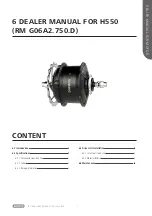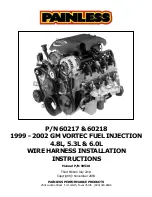
Wren 44 TurboProp Users Manual. Copyright Wren Turbines Ltd February 2008 Page 19
Hopper Tanks and UAT’s
Hopper tanks and UAT’s (originally the Ultimate Air Trap from BVM Models) are a popular choice
and can help with the consistency of fuel supply – especially on aerobatic models. The standard
hopper tank is simply a small capacity fuel tank which is fully sealed and has a single fuel-in pipe
and a fuel outlet positioned centrally so it can pull fuel from any attitude the plane finds itself in.
The UAT is similar except it has a membrane type pickup on the fuel-outlet which acts as a
sponge and allows fuel to pass but without allowing air into the system.
Fit the UAT or hopper tank between the fuel tank and fuel pump – take great care to ensure a
totally fuel tight pipe run from tank to UAT/hopper and then onto the fuel pump. Purge all air
bubbles from the UAT or hopper before use. Monitor the remaining fuel level in the UAT/hopper
as this is a good indication of of air getting into the system. If this level drops noticeably during a
flight and there is still fuel remaining in the tank, then suspect an air leak, find and cure it before it
causes a stoppage.
UAT’s are helpful, but the guide still applies – keep the tank capacity well above the flight time
requirement so the tank clunk is not chasing the last dregs of fuel around at the bottom of the
tank.
Flight Time Endurance
How long a plane can fly on a given quantity of fuel is only of academic interest to most but it
does give an idea where in the flight envelope is the most economical for those with an eye on
the longest flight times!
Looking at the graph above, a steady 100,000rpm on the engine equates to about 25N (5-1/2lbs)
thrust from the propeller, which is enough to keep a plane of 10-15kg (22-33lb) aloft at
reasonable altitude. In this case you could expect over half an hours flying on the recommended
fuel tank.
Note that for most aircraft, though it is perfectly feasible to anticipate a flight of over half an hour
of gentle flying, this would not only be a true test of piloting but also of the on-board ECU battery
(LiPo) which may be marginal if not fully charged before take-off. If you plan to attempt such
marathon flights we recommend a larger capacity LiPo for the ECU battery, possibly also a larger
receiver battery too (also a well charged transmitter), so there are no embarassing “quiet”
moments when the engine slows and dies and you have to land with fuel remaining but no
engine.
You can see where the engines reputation as being “stingy” with fuel comes from.
Flight Duration to Engine RPM for 1.5ltr
Tank
0.0
20.0
40.0
60.0
80.0
5
5
1
0
0
1
3
0
1
6
0
1
8
0
1
9
5
Engine RPM x 1000
F
ly
in
g
t
im
e
i
n
m
in
Flight Duration to Engine RPM for
50oz Tank
0.0
20.0
40.0
60.0
80.0
5
5
1
0
0
1
3
0
1
6
0
1
8
0
1
9
5
Engine RPM x 1000
F
ly
in
g
t
im
e
i
n
m
in
















































